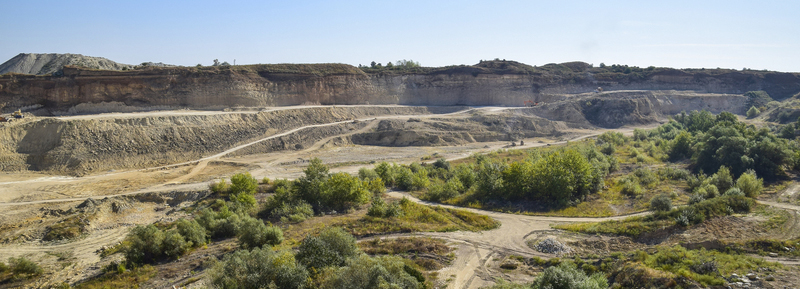Considerations for Selling Contaminated Property in NJ
Reducing Long-Term Risk and Exposure to Environmental Liabilities
Despite the impact of COVID-19 on other areas of commercial real estate, the industrial sector continues to thrive as the e-commerce industry seeks properties for warehousing and logistics centers, especially in close proximity to New Jersey’s advantageously-placed ports and arterial highways that provide “last mile” delivery capabilities. The fact that many of these properties are located within industrial or former industrial areas has not stopped purchasers who have become increasingly more comfortable with sites that are environmentally impacted, even in some instances taking on long-term, ongoing environmental obligations. Although opportunities abound to offload these properties and their environmental burdens, sellers should be mindful of limiting their exposure to liabilities that may manifest after the sale. Though most owners of contaminated property can never completely eliminate the threat of future liability, below are a number of practical tips and considerations for addressing and reducing long-term environmental risks, many of which are applicable to the sale of any type of contaminated property.
- Indemnities and Releases – The most common contractual tools that sellers use to protect themselves from post-closing liabilities are indemnities and releases. In brief, an indemnity requires one party (e.g., the buyer) to defend and reimburse another (e.g., the seller) for specified claims, liabilities, damages, cost, expenses, etc., while a release prohibits one party (e.g., the buyer) from making certain claims against another party (e.g., the seller). Sellers offloading contaminated properties should pay careful attention to the scope of any indemnities and releases. If a seller wants to transfer all environmental responsibility and liability to its buyer, seller may want to ensure that the indemnities and releases are drafted as broadly as possible and include any environmental cleanup obligations that might fall on seller in the future as well as any third-party claims, whether by a governmental entity for, say, natural resource damages or by a neighboring property owner or future occupant of the property for personal injury. Alternatively, if a seller intends to retain certain liabilities, then those liabilities should be specifically excluded from any indemnities and releases, and, in fact, seller may indemnify buyer for such liabilities. In any event, the scope of the indemnities and releases is a crucial tool for allocating environmental responsibility and should match the intent of the parties.
- Financial Protections – Although indemnities and releases may provide useful protection, sellers sometimes also rely on additional financial protections, especially given that an indemnity is only valuable if the entity providing the indemnity has the resources to satisfy potential claims. In fact, because many developers purchase properties through a single purpose entity and the only asset it owns is the property itself (which may be encumbered by financing or diminished in value as a result of environmental contamination), the indemnity may not be sufficient. When this is an issue, sellers often consider requiring a parent company or personal guaranty or some other financial protection like an appropriate escrow. These protections endeavor to guarantee that resources will be available to satisfy a purchaser’s responsibilities.
- Post-Remedial Obligations/Financial Assurance – Where contamination remains on-site underneath an engineering control (e.g., a cap), the control must be monitored and maintained over time in accordance with required permits. If seller will retain responsibility for these obligations, it should insist on an express right to access the property after the sale. In fact, seller may want to create a stand-alone access agreement that is recorded on the land so that if the property is subsequently sold, seller’s right to access runs with the land and is binding on subsequent owners. Alternatively, if it will be the buyer that assumes these obligations – (which is the more common scenario, as buyer will be in the best position to perform the necessary monitoring and maintenance of the cap after the property is sold) – seller should ensure that buyer affirmatively assumes all of the obligations, including posting appropriate financial assurance.
- Extending Seller Protections to Future Owners – Often a purchaser will develop a property and then sell it to an end user, and inevitably the property may change owners over time. This can leave the original seller exposed if its direct purchaser either does not continue to comply with its long-term environmental obligations or if it does not appropriately transfer those obligations to a subsequent purchaser. While there is no silver bullet to protect from this risk and each approach has its shortcomings, one way to attempt to address this concern is including indemnities, releases and other affirmative environmental obligations in the recorded deed of sale. Another way is to use a rollover provision in the sales contract that would expressly require purchaser to include language in any future sales agreement that obligates the new purchaser to indemnify and release original seller and to assume the ongoing environmental obligations.
- Reopeners and Changes in Controls and Property Use – Another risk to sellers is that the remediation of the property may be subject to what we commonly refer to as a “reopener.” For example, if unknown contamination is found, remediation standards change, or the property is put to a new use that requires additional remediation, seller, as the original responsible party, may have a legal responsibility to address the reopener. Given this risk, the parties should consider explicitly identifying which party will be responsible for these obligations via the contract of sale. Also, since the property may not be in its final form to accommodate warehousing or another ultimate end use at the time of the sale, the contract should specify which party is responsible for any changes to the institutional and engineering controls and modifications to any permits that may be necessary to accommodate the redevelopment. While these may seem like small details, specifically addressing these items adds clarity to the parties’ responsibilities, which can limit future disputes.
- Self-Help Provisions – While sellers regularly endeavor to put themselves in the best position to avoid unknown liabilities that may arise in the future, it is important to plan for the worst-case scenario. Thus, in the event that the purchaser does not live up to its contractual obligations, seller should consider including in its sales agreement a “self-help” provision that would allow it to return to the property to address any environmental situation. Sometimes, when a purchaser defaults, it is better to take affirmative steps and limit any additional damage than to wait for the purchaser to address it.
- Insurance – In addition, or as a supplement, to the protections mentioned above, environmental insurance can be a good way to fill some of the risk gaps in specific transactions, especially for remediation of unknown environmental conditions and third-party bodily injury and property damages claims that may arise after the sale, and which are often difficult to investigate during acquisition. Seller may want to purchase, or obligate its buyer to purchase, an environmental insurance policy to cover certain environmental liabilities related to the property. While an insurance policy can be a good way to transfer risk (especially to a party outside the transaction), a note of caution – environmental policies have many exclusions and should be carefully negotiated and tailored to fit the specific needs of the property and transaction. Experienced insurance brokers and environmental legal counsel can guide sellers through this process.
While sellers would love to sell a property and never look back, the reality is that long-term environmental risks and future liabilities cannot be completely eliminated. As such, sellers should consider taking appropriate steps to limit their exposure and the potential for future disputes. Each transaction is different and individual properties have their unique sets of issues and considerations, so it is important to engage experienced counsel to assist in addressing and mitigating these risks.
For more information, please contact the author Jaan M. Haus at jhaus@riker.com or any attorney in our Environmental Practice Group.
Governor Murphy Makes an Investment in the Future of New Jersey's Offshore Wind Industry
New Jersey has set an ambitious goal to supply 7,500 MW of offshore wind energy to the State by 2030. In order to meet this goal, New Jersey will be required to provide port services to support the development of offshore wind farms. To that end, Governor Murphy included $200 million in the State’s budget to construct an offshore wind port located in Salem County. Moreover, the facility will be utilized for manufacturing, marshalling and supply chain activities. This is in addition to the $250 million pledged by Orsted and EEW Group, a German large-scale pipe manufacturer, to build a facility at the Paulsboro Marine Terminal that will manufacture monopiles, which serve as foundations for offshore wind turbines. This significant investment in offshore port facilities will allow New Jersey to not only promote wind farm development off its coast but also become a hub for the growing offshore wind industry along the entire East Coast.
The Salem County Wind Port and Paulsboro Marine Terminal will provide docking facilities for vessels used in the construction, cabling and maintenance of wind turbines. These facilities will have areas where wind turbine components can be manufactured, staged and assembled prior to transport to the offshore wind farms. There are a number of considerations when designing an offshore wind port facility, including sufficiently sized storage capacity for the extremely large wind turbine components and the ability to support the weight of such components and foundations. Unfortunately, unlike Europe, the United States does not have significant coastal land area to develop mega-ports, which are the most useful for the industry. Therefore, states along the East Coast seem more likely to develop an integrated port network to ensure that the offshore wind developers have the facilities they need to complete their projects. The 200-acre-planned Wind Port in Salem County and the 190-acre Paulsboro Marine Terminal are anticipated to be an integral part of this network.
Moreover, the recently enacted National Defense Authorization Act for Fiscal Year 2021 dispelled any question as to whether the Jones Act will apply to offshore wind farms located on the Outer Continental Shelf. The Defense Authorization Act clarified that the Outer Continental Shelf Lands Act covers facilities producing non-mineral energy sources attached permanently to the Outer Continental Shelf, such as wind turbines, thus, making these turbines subject to federal law. This in turn will require developers to utilize Jones Act compliant vessels (vessels that are US owned and operated) when transporting wind turbine components from a US port to the wind farm for construction, operation or maintenance. Therefore, the ability to manufacture wind turbine components at a US port is critical to the development of offshore wind along the Eastern seaboard.
Development of the ports are likely to invoke environmental justice concerns, which is a priority for the Murphy Administration. The Salem County Wind Port and the Paulsboro Marine Terminal, both located near identified overburdened communities, will almost certainly provide jobs to individuals living in these communities in construction, manufacturing, loading, marshalling and maintenance of the turbines. The Town of Grimsby located in the United Kingdom is an example of a community that benefitted from the development of a port facility to support offshore wind. Grimsby was a struggling fishing village, but that changed when an offshore wind port brought a supply chain of manufacturers, suppliers, support vessels and services to the Town. In a short period of time, Grimsby saw significant economic growth and opportunity because of the offshore wind industry, which can be a model for Salem and Paulsboro.
But, along with anticipated economic growth, the operations at the Salem County Wind Port and the Paulsboro Marine Terminal could result in environmental and health impacts to the surrounding communities. As the ports develop into a hub for the East Coast offshore wind industry, there could be an impactful increase in vessels and other transportation vehicles, which in turn could be detrimental to air quality in the region. Additionally, manufacturing facilities could increase air emissions, water discharges and the generation of waste. Although there is strong support for renewable energy, New Jersey is likely to consider and address, along with beneficial growth, the potential environment and health concerns in offshore wind port areas.
While this is just the beginning, Governor Murphy’s $200-million investment in creating the Salem County Wind Port and the $250-million venture at the Paulsboro Marine Terminal bring not only the anticipation of jobs and growth to the area, but they also begin to solidify New Jersey’s role as an integral part of the offshore wind industry.
For more information, please contact the author Laurie Sands at lsands@riker.com or any attorney in our Environmental Practice Group.
NJ Cannabis Industry To Focus on Environmental Considerations
Most people don’t think of the environmental impact of cannabis, but producing cannabis products can be energy intensive and involve issues relating to water, air quality, and waste management. In New Jersey, where the recently legalized adult-use cannabis industry has been estimated to be worth more than $2 billion annually, cannabis operations will be required to consider and address environmental impacts. In fact, both the new law regulating the adult-use cannabis industry in the Garden State, as well as the prior laws regulating the Medical Marijuana Program, obligate prospective cannabis businesses to prepare and submit an environmental impact plan as part of the competitive licensing process. Cannabis businesses looking to operate in New Jersey should prepare early in the planning process to focus on environmental considerations, bringing together architects, engineers, and environmental professionals to do so. Put simply, minimizing environmental impacts will improve a prospective cannabis business’s chances of securing a license.
Governor Phil Murphy signed legislation on Feb. 22, 2021 to legalize and regulate adult-use cannabis in New Jersey. As under New Jersey’s Medical Marijuana Program, the law requires businesses seeking to engage in the cannabis industry to obtain licenses, at least some of which will be limited in number, and awarded through a competitive process that is scored based on different aspects of the licensing application. As part of the competitive application process, prospective cannabis businesses will need to prepare and submit an environmental impact plan, which will be scored as part of the overall application.
To date, New Jersey has provided little guidance on the proper components of environmental impact, odor mitigation, and waste disposal plans for cannabis businesses. Additionally, although the New Jersey Department of Health (“DOH”) has published information about licensing applications submitted under the Medical Marijuana Program, we are not aware of any environmental impact plans from these prior applications that have been made public.
However, the DOH previously promulgated regulations and issued guidance regarding management of cannabis waste. The DOH defines appropriate waste management alternatives based on whether the waste is “usable marijuana” (i.e., the dried leaves and flowers of the female marijuana plant, and any mixture or preparation thereof), “unusable marijuana” (i.e., marijuana seedlings, seeds, stems, stalks, roots, and large fan leaves), and any marijuana waste that is considered hazardous.
- Usable marijuana must be stored in a locked area until it can be escorted by DOH staff to a permitted incinerator and destroyed.
- Marijuana waste that is hazardous must be stored in a locked area as well and disposed of in a manner appropriate for hazardous waste pursuant to the Resource Conservation and Recovery Act.
- Unusable marijuana may be disposed of as solid waste or by composting, provided that the marijuana is finely shred or ground, and mixed with at least 50% non-marijuana waste by volume.
While the ability to compost cannabis waste reduces the environmental impact of cannabis operations, other states, including Colorado, have improved on the foregoing requirements to further reduce the impact associated with managing cannabis waste (e.g., by relaxing the 50% mixing rule). It is important to note that the New Jersey Cannabis Regulatory Commission will promulgate regulations to govern the adult-use cannabis industry, and the Commission may promulgate regulations that differ from the foregoing DOH regulations and guidance.
Prospective cannabis businesses also may look for guidance on environmental impacts to the National Cannabis Industry Association, which issued a report in October 2020 titled “Environmental Sustainability in the Cannabis Industry: Impacts Best Management Practices and Policy Considerations.” This comprehensive document details the potential environmental impacts of the cannabis industry and presents best practices to mitigate these impacts. As is summarized in the “key takeaways” of the guidance: “Optimizing all resource usage in the cannabis industry will simultaneously reduce environmental impacts and increase profit margins while maintaining product quality.” Obviously, growing and manufacturing operations will have the greatest potential for environmental impact, and, therefore, for reducing such impact, but retail and other operations still have an opportunity to develop business plans that further sustainability and climate change efforts. For instance, retail operations should focus on properly managing packaging and paper waste to the maximum extent practicable.
In any event, cannabis businesses in New Jersey will be required to comply with applicable environmental laws and legal requirements relating to air quality, water usage and quality, and waste management. As noted above, minimizing environmental impacts also will improve a prospective cannabis business’s chances of securing a license. Consequently, prospective businesses are encouraged early in the planning process to consult with appropriate professionals to evaluate and minimize environmental impacts.
For more information, please contact any attorney in our Environmental Practice Group.
New Incentives for NJ Brownfields Redevelopment
An Overview of New Jersey’s Brownfields Redevelopment Incentive Program
New Jersey is rolling out a new tax incentive program for the redevelopment of underused, contaminated properties, known as “brownfield sites.” In fact, on January 7, 2021, Governor Phil Murphy signed into law the New Jersey Economic Recovery Act of 2020, P.L.2020, c.156 (the “Economic Recovery Act”), a broad piece of legislation that provides support for a variety of programs and policies related to jobs, small businesses, sustainable energy, and many other areas. Sections 9 through 19 of the Economic Recovery Act establish the Brownfields Redevelopment Incentive Program Act (the “Program”), which supplements the existing Brownfield and Contaminated Site Remediation Act. Put simply, the Program allows the New Jersey Economic Development Authority (“EDA”) to award up to $50 million in tax credits annually for six years to redevelopment projects in need of financial assistance to address environmental contaminants or hazardous building material, such as asbestos.
This article provides an overview of the Program and certain issues that developers may face based on our experience with similar incentive programs, including the predecessor to the Brownfields Redevelopment Incentive Program.
Eligibility Requirements
Projects will be eligible for tax credits only if the redeveloper demonstrates the following in its application:
- The redeveloper has not conducted environmental remediation work at the site other than preliminary assessments or site investigations. However, and while this concept will need to be more accurately defined through regulations or guidance, redevelopers who have begun remediation are eligible for tax credits if they can certify that they could not reasonably have known the extent of the contamination when they began the project;
- The project is located on a brownfield site;
- The project needs tax credits to be economically feasible;
- The project has a finance gap, which means the redeveloper itself has contributed at least 20 percent of the capital for the project, but is unable to raise the necessary funds for the project without tax credits;
- The municipality in which the project is located must provide a letter of support;
- Redevelopers must pay a prevailing wage to every worker performing remediation or construction on the project; and
- The redeveloper is not responsible for causing the contamination.
Available Tax Credits
Redevelopers who are awarded tax credits and complete their redevelopment projects in compliance with the Program requirements will be awarded a tax credit equal to 40 percent of the remediation costs or $4 million dollars, whichever is less. As noted above, however, only $50 million is available to be awarded on an annual basis.
Competitive Application Process
The EDA and the New Jersey Department of Environmental Protection (“NJDEP”) will adopt regulations describing how to submit applications requesting tax credits for brownfield redevelopment projects, and will set an annual application due date. The EDA and the NJDEP will jointly review all applications and will consult with the Department of Labor and Workforce and the Department of the Treasury as to whether redevelopers seeking tax credits are in good standing with the respective departments. We expect that there will be more applicants than available tax credits and, therefore, that the Program will be competitive. In evaluating and prioritizing certain projects, the EDA and the NJDEP are authorized to use any of the following factors: the economic feasibility of the project; the degree to which the project promotes economic development and addresses environmental concerns in communities disproportionately impacted by environmental hazards; and, if the redeveloper has a board of directors, the extent to which the board of directors is diverse and represents the community in which the project is located.
Lessons from Prior Experiences
Based on our prior experience with similar programs, developers that are interested in the Brownfield Tax Incentive Program should begin planning early in the development process, especially given how competitive we expect the application process to be for these tax credits. Developers also should ensure that they conduct a thorough environmental investigation in connection with acquisition of brownfields for which they plan to seek tax credits, as such an investigation may be a prerequisite to eligibility for such tax credits. Lastly, early planning also is important under the Program because of its focus on community support and environmental justice. Developers that want to be ready to seek tax credits as soon as the Program comes online fully may want to begin outreach to community groups now.
The Program is in its infancy, but the Brownfields Redevelopment Incentive Program Act builds on a legacy of incentives for remediation projects in New Jersey and promises to foster redevelopment projects that may change the course of many communities across the Garden State.
For more information, please contact the author Jason Boyle at jboyle@riker.com or any attorney in our Environmental Practice Group.










